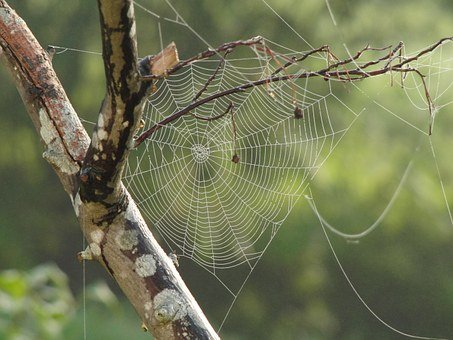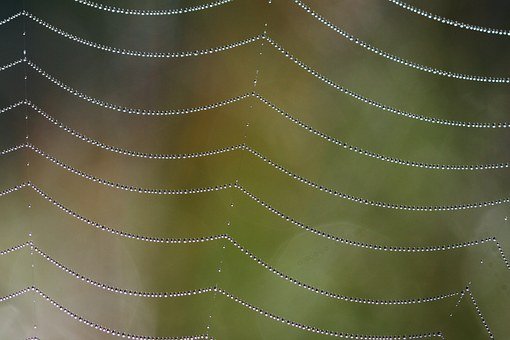Spider Silk: The Answer to the Need for Light-Weight Body Armor
This post describes biomimicry and its possible use in making body armor out of spider silk or a similar material.
Recently, scientists and engineers have turned back to nature for inspiration and help in solving some of science’s, the military’s, and the public’s problems; this method, called biomimicry, has been quite successful thus far. In the question of creating light-weight body armor that successfully protects soldiers and officers of the law from ballistics and shrapnel, scientists have turned to spider silk for the answer.

Spider Silk
Spider silk has remarkable properties, which ostensibly find there basis in its structure and composition. In general, a spider can produce about six different types of silk all of which serve a specific function for the spider and have slightly different compositions and structures. For instance, the Argiope argentata spider has five different types of silk that have separate functions: dragline silk, “used for the web’s outer rim and spokes, and the lifeline while making the web; capture-spiral silk, a very sticky and flexible silk used to capture prey; tubiliform silk, which is the stiffest silk and used to protect the egg sacs; aciniform silk, which is two or three times stronger than the other types and is used to wrap and secure captured prey; and minor-ampullate silk, which functions as temporary scaffolding during web construction.
Moreover, not only can spiders produce different types of silk of different structures and composition but also the silks’ structures and compositions vary slightly among species of spiders. The large amount of variety among spider silks has made culminating a large amount of research on these silk types very challenging. Dragline silk, also called major ampullate silk, has been studied most extensively among all the silks. Dragline silk, as is true of all spider silks, is a protein fiber, which has alternating crystalline and amorphous sequences. However, the sequence of amino acids and the formation of the crystalline and amorphous structure is better understood and known with specificity in dragline silk. There are two proteins in the fibers of dragline spider silk. One is rich with the amino acid alanine and the other is rich in the amino acid glycine. The ala-rich protein folds into beta-sheets, a type of structure, which connects by comparatively strong hydrogen bonds to form the crystalline structure. These lie in a glycine-rich matrix that connects the ala-rich beta sheets to each other with pre-strained chains.

The Spinning Process
The process of spinning the dragline silk is extremely important in itself because it accounts for some of the silks unique properties. The silk is made in the ampulla, the silk gland, where in the A-zone secretory region the proteins are manufactured and grouped together, then in the B-zone secretory region the proteins are mixed with carbohydrates and peroxidase, which will be the coating on the spider silk. Next, the nascent silk mixture leaves the ampulla through a funnel and enters the long S-shaped spinning duct, which is divided into three regions that grow narrower as they approach the spinneret. The proximal and medial limbs of the spinning duct serve to remove water from the silk mixture, and the distal limb of the spinning duct serves to bathe the silk mixture in an acidic bath created by proton pumps. At the end of the distal limb a lipid layer is added to the newly formed fiber, then the silk fiber exits the through the spinneret. This is an important process because the silk goes from a mixture to fiber through this long and winding process, which aligns the amino acids in just the correct way to give the silk its alternating crystalline and amorphous regions. Moreover, even though scientists know the proteins in the dragline silk and the genes coding for them they cannot replicate this process artificially.
Functions of Spider Silk
Spiders utilize silk for many different functions. Spiders use their silk to make their webs, protect their eggs, migrate to different environments by ballooning, assist in mating process, shelter themselves, and immobilize their prey. Spiders transport themselves longer distances by letting up a really fine type of silk called gossamer, which the wind catches and carries the spider along with it. The spiders also use their silk as a source of nutrition because the process of making and spinning silk is labor intensive; consequently, spiders eat their silk to recycle the silk proteins without having to use energy to make more. The silk would not be as effective in these functions if it was not as strong and elastic— properties which are account for by the silk’s structure, composition, and spinning process.

Evolution of Spider Silk
From an evolutionary perspective spiders evolved the ability to make silk to conserve energy in the hunting process— using webs as prey traps uses less energy than chasing down prey; to protect their young from predators; and to aid in the mating process, so that generations of spiders continue. Moreover, this silk had to be strong in order to support the weight of the spiders, which usually are large compared to the size of their web, and to catch prey without tearingSpider silk is an incredibly unique product of evolution and the biological world, and is now a source of inspiration for many practical uses.
Engineering Applications of Spider Silk
The engineering applications of spider silk are almost endless because of its incredible strength and flexibility. For instance, The Caerostris darwini spider produces silk that is “over 10 times stronger than Kevlar”, which is a synthetic fiber that is woven to make bullet resistant vests. Ostensibly, scientists are looking to make lightweight body armor from spider silk. Spider silk can also be used to make sutures, lightweight parachutes, and artificial ligaments. These would all be a direct application of spider silk to solve scientific, civic, and military problems; however, the direct application of spider silk for these is not currently feasible because spiders do not make a great deal of silk and breeding large groups of spiders and keeping them in the same place is not feasible because of their predatory and often cannibalistic nature. Scientists have tried to artificially produce spider silk by genetically manipulating silkworms, E.coli, and goats; however these organisms cannot produce the same proteins as spiders nor can they produce silk with the same strength and flexibility.

Synthetic Solution to Spider Silk Production
Consequently, scientists have tried to replicate the properties of spider silk: strong tensile strength, high elasticity, and low weight, in synthetic fibers. Synthetic fibers like Kevlar are very similar in there structure and chemical properties to the spider silk. Kevlar is a polymer and spider silk is a biopolymer and both have liquid crystalline structures. Kevlar’s great tensile strength is derived from this crystalline structure like silk proteins because the structure allows for numerous intermolecular bonds between carbonyl groups and NH centers on the polymer’s chains. Aromatic stacking interactions act between adjacent strands of the Kevlar polymer giving it more strength. Thus, in a lot of ways Kevlar and similar synthetic fibers successfully mimic the properties of spider silk. There are now light-weight ballistic resistant vests and suits that protect military personnel and officers of the law that are significantly lighter then the ballistic resistant wear that is made from ceramics. However, the body armor made of synthetic fibers is not perfect. It still does not have the same tensile strength as spider silk and is not as elastic either. Overall, the use of synthetic fibers like Kevlar, which are manufactured with the intent to replicate the properties of spider silk, in bond armor to protect military personnel in battle and police officers on the job is a paradigmatic example of biomimicry.
Work Cited
"Researchers Hope to Harness Power of Spider Silk." Physorg. Arizona State University
"Spider Silk." Wikipedia.
Papadopoulos, Periklis, et al. "Similarities in the Structural Organization of Major and Minor Ampullate Spider Silk." Macromolecular Rapid Communication.
"Functional Anatomy of Silk Gland and Spinning Duct." Biomimetic Fibers at Clemson. Clemson University, n.d.
"Biologists Unravel the Genetic Secrets of Black Widow Spider Silk." Physorg. University of California - Riverside.
"Properties, Uses and Production." Spider Silk. University of Bristol http://www.chm.bris.ac.uk/motm/spider/page2h.htm
Images by Pixabay.com